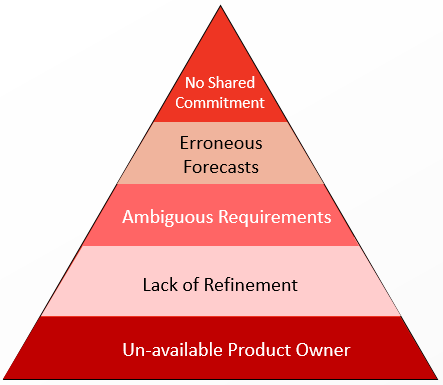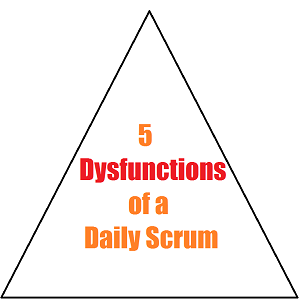In my previous post I introduced the role of Scrum Master. And it is pretty clear that being a Scrum Master is no easy job. This person has to keep changing styles and stances as and when needed. However, when someone with not enough knowledge or experience picks up this hat, it often leads to Scrum Master Anti Patterns.
In this post I am sharing the anti-patterns and its pitfalls that I experienced, there could be more.

Anti-pattern: Scrum Master as a technical lead
This person has played a role of technical lead for quite long. Is well aware of the technology and also understands the business domain very well. When the team was transitioning to Scrum, this person gets into the role of Scrum Master; however has not yet let go off the old behaviour. This person keeps on making decisions for the team. Pushes technical choices on the team. Influences the estimates given by the team. In short, still plays the role of technical lead.
Pitfalls:
- Team becomes more dependent on this one person.
- Team may not be able to take decisions in absence of this person.
- Impacts the self-organisation of the team.
- No ownership within the team.
Anti Pattern: Go between the Product Owner and Development Team
The Scrum Master becomes the point of contact between the Product Owner and the Development Team. Any clarifications the Development team seeks or if the Product Owner has any doubts for the development team, Scrum Master is seeked first. Every information between the Product Owner and Development Teams runs through the Scrum Master only. No direct channel between the PO and DT is established.
Pitfalls:
- Information may be lost.
- Self-organization gets impacted.
- Collaboration is impacted.
- Delay in response, either team waits for SM to get information from PO or vice-versa.
Anti-pattern: Scrum Master is incompetent
The Scrum Master has to wear multiple hats as per the need of the situation. If this person is incompetent then he/she would struggle to juggle between the different styles and stances. When this happens Scrum Master may become indecisive as he/she may not have the right knowledge and experience to help the team.
Pitfalls:
- Lack of understanding of Scrum in the team.
- Loss of trust between the Scrum Master and the PO/Development Team
- Scrum Master being incompetent himself/herself, will not be able to create the culture of accountability.
Anti-pattern: Scrum Master acts as a Manager
Scrum Master is not a “Manager” and this message needs to be well understood. Most often when we say SM is a management position; people tend to associate it with the traditional manager and they tend to behave like traditional managers. I have seen in my personal experience where the bearers of this role conduct one-on-one formal meetings with Development Team members to identify and create their career path; talk about their promotions and so on.
Pitfalls:
- Development Team doesn’t feel the Scrum Master as a part of their team.
- Development team is hesitant to share their challenges.
- SM acts as a person with authority.
Anti-pattern: Silent Scrum Master
This is a very problematic anti-pattern. In this situation, the Scrum Master is always silent. This person does not contributes to the team in any way. He/She is more of a loner, aloof from the team staying in his/her own world. Being a loner makes the Scrum Master defensive. He/She believes only what they think is right, they do not socialize or take support from organizational structures like CoE, peer Scrum Masters etc.
Pitfalls:
- Knowledge is limited.
- They become rigid; don’t want to change.
- Their perspectives are limited and can’t do much for the team.
Anti-pattern: “Happy-go-Lucky” Scrum Master
This Scrum Master believes in self-organization of the team to such an extent that the Development Team has no boundaries. There is no respect for the principles and rules of Scrum. No respect for time-boxes; for scrum values; for events and for the roles. The team becomes indisciplined and complacent; doesn’t believe in the purpose of Scrum. Product Owner breaks his/her boundaries; pushes team to unethical behaviours; doesn’t respect teams choices and so on.
In short, the SM forgets that self-organisation happens within boundaries; self-organisation does not mean that everyone is free to do what they want or like.
Pitfalls:
- Indiscipline within the team.
- No collective ownership.
- Lack of accountability towards team.
- No common vision or purpose of the team.
- Lack of clarity why we are building a product.
Anti-pattern: Scrum Master is also the Product Owner
The SM is also the Product Owner for the team. This person is now responsible for making the Product successful as well as creating a safe-environment for the team.
Pitfalls:
- Conflict of interests.
- Pushing things down the development team.
- Not allowing teams to self-organise to select the work they want to do keeping in mind PO priorities.
- Development team may not open up about product challenges not being sure to whom they are expressing their concerns.
Anti-pattern: No respect for the Scrum Framework
Someone has taken up the role because there was a transition within the organisation. This person does not believe in Scrum framework, Scrum values or the rules of Scrum.
Pitfalls:
- No encouragement for the team/organisation to adopt Scrum.
- Lack of trust and transparency.
- SM directs the team.
- Falling back to traditional mindset.
- Not embracing change.
- No belief in the possible product, incremental and iterative delivery model.
If you find yourself in any of the above situations as a Scrum Master, it is a high time for you to inspect and adapt.
Addendum:
https://www.scrum.org/resources/blog/scrum-master-what-your-inner-compass
https://www.scrum.org/resources/8-stances-scrum-master



0 Comments